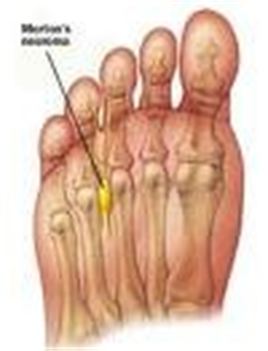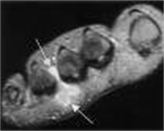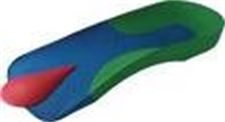Morton's Neuroma
Morton's Neuroma is a common, painful, condition affecting the base of the toes, usually the third and fourth toes.

This is a degenerate change of the nerve that supplies your toes. Due to repeated injury of this nerve. A neuroma can also occur between second and third toes. The pain happens because the nerve that divides between the metatarsal bones (toe bones) is irritated or compressed.
The cause of this irritation is not exactly known, but it may be the metatarsal bones compressing the nerve when the gap between the bones is narrow. This causes the nerve to become inflamed and over time thickened.It is rare for more than one nerve to be affected, and it usually only affects one foot.
Morton's Neuroma treatment animation
Symptoms
The symptoms of Morton's Neuroma can occur unexpectedly and get progressively worse with time. Morton's Neuroma causes sharp or dull pain between the toes (usually the third and fourth toes). The pain occurs while you are walking and will cause you to stop and remove your shoe. It makes some people with the condition anxious about walking or even placing their foot on the ground. Keeping the weight off your feet or rubbing your foot can lessen the pain. The nerve pain can be made worse by wearing tight shoes. Other symptoms of Morton's Neuroma are:
Causes
The exact cause is not always known. However anything that causes compression or irritation of the nerve can lead to the development of a Neuroma. Repetitive injury to the nerve will cause thickening and the lump that forms around the nerve further irritates this so symptoms can become worse. Narrow footwear, high heels can cause injury to the nerve. People with certain foot deformities – bunions, hammertoes, flat feet, or more flexible feet – are at higher risk for developing a Neuroma. Other potential causes are activities that involve repetitive irritation to the ball of the foot, such as running or court sports.
Diagnosis
To diagnose Morton's Neuroma I usually palpate the area to elicit pain, squeezing the toes from the side. Next may try to feel the neuroma by pressing a thumb into the third interspace. Then try to elicit Mulder's sign, by palpating the affected interspace with one hand and squeezing the entire foot at the same time with the other hand. In many cases of Morton's Neuroma, this causes an audible click, known as Mulder's sign.

An x-ray should be taken to ensure that there is not a fracture. X-rays also can be used to examine the joints and bone density, ruling out Arthritis (particularly Rheumatoid Arthritis and Osteoarthritis).
An MRI scan (magnetic resonance imaging) is used to ensure that the compression is not caused by a tumor in the foot. An MRI also determines the size of the neuroma and whether the syndrome should be treated conservatively or aggressively.
Non-surgical treatments
Treatment approaches vary according to the severity of the problem. For mild to moderate neuroma, treatment options may include:
- Shoe Advice
Wide fitting supportive footwear will reduce severity of symptoms Padding techniques and Orthotic (insoles)These provide support for the metatarsal arch, thereby lessening the pressure on the nerve and decreasing the compression when walking. However may exacerbate symptoms as will take up room in shoes and tight shoes will aggravate symptoms.
Padding techniques and Orthotic (insoles)These provide support for the metatarsal arch, thereby lessening the pressure on the nerve and decreasing the compression when walking. However may exacerbate symptoms as will take up room in shoes and tight shoes will aggravate symptoms. - Activity Modifications
Activities that put repetitive pressure on the neuroma should be avoided until the condition improves. - Injection Therapy
An injection of local anaesthetic to relieve pain and a corticosteroid to reduce inflammation may be administered. The patient is advised to return in 6 weeks to monitor progress. If the pain has been relieved, the neuroma is probably small and caused by the structure of the patient's foot and the type of shoes the patient wears.
Another type of therapy that may be used is alcohol sclerosing injections. In this treatment, a small amount of alcohol is injected in the area of the neuroma to help harden (sclerose) the nerve and relieve the pain. Injections are given every 7–10 days and, in many cases, 4–7 injections are needed for maximum relief.
Cryosurgery
Cryosurgery uses extremely cold temperatures in order to selectively destroy neuroma tissue. The aim of this procedure is to shrink tissue and to disrupt the blood supply to abnormal tissue. The technique originates from the USA Results do vary and clinical trials are still being undertaken. For more info see: www.cryosurgery.co.uk

